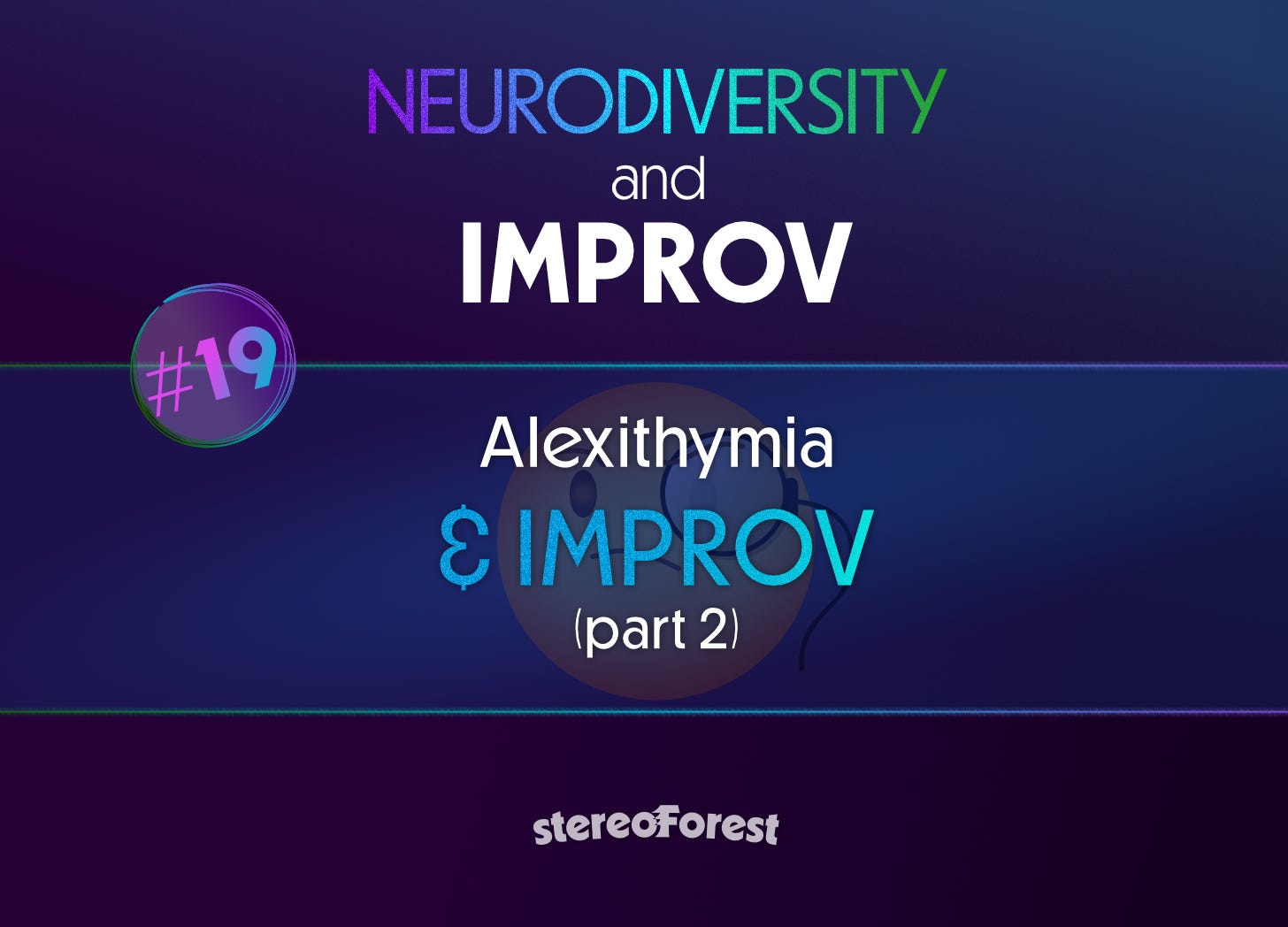Alexithymia and Improv - Part Two
If you improvise with or teach more than 10 people, you've probably done improv with someone that experiences alexithymia. Learn to support yourself or others when working with emotions in scenes.
Note: Full written articles are available to paid subscribers. This topic will be released for everyone as a podcast episode/transcript next week - yay!
In part one, we looked at what alexithymia is, who experiences it and the variety of expression, and how it affects improv performers and the shared improv practice.
This part (aka part two!) explores some ideas about what students can do if they approach exercises with assigned emotions. I also discuss what teachers can do to make their classes and exercises more inclusive for students who are alexithymic.
Listen to this post:
Students: Tips for doing exercises
In the previous part of this series, I described using emotions in a scene with a scene partner. Alexithymia affects about 10% of the general population, so you most likely improvise with someone who has it. Or you might even experience it yourself, and you might not have realized it was even “a thing” or why you felt challenged when dealing with emotions or emotional labels.
An any case, you might not realize you or your teammates have challenges expressing or interpreting emotions. So let’s look at this in more detail.
The things I described in part one of this series:
What alexithymia is, and how some people experience it with resources to learn more. There is a lot of variety in what this is expressed and feels like depending on the cause and co-morbidities.
How alexithymia challenges improvisers when they experience it.
What improvisers can do in performances, and on their teams, if they reckon they have alexithymia.
So go back to part one to learn the basics, especially if you’re interested in performing in scenes.
In classes and jams, you might be asked to use an emotion to start a scene, or you might even be asked to start with a certain emotion and reach a different emotion by the end of a scene. And there are many variables in between.
And as an aside about doing exercises like this: feel free to look at an emotion chart for those times you are asked to grab any emotion. I’m not sure why, but using one of those charts helps me improve my results about 14%. I don’t know why, but it seems to (maybe it’s all the colors, or a distraction from the stress of the query, I don’t know. I suddenly remember 14% more of emotions if I look at the words).
And if those charts make it worse, as it could for some, avoid them. Simple? Ha! :)
“Show don’t tell” - maybe you’ve heard this
Show don’t tell just means that we aren’t using words to say “I feel tired!” - you try to access tired in your body and just show it physically. This is common instructional advice.
But for the sake of this series, remember you can ignore the labels. Pick a time, if you can, where you physically felt something in reaction to an event of some sort. Can you access it again? Can you feel that, or something that resembles it?
Does the label make you feel something in your body. Does the label make you flash memory to an experience. See what these things make you access. For me, it helps to go to an experience I have analyzed already.
You don’t need to use words, or descriptors, in the scene. Or you can. In my opinion, all of these are valid. However you get there, as yourself or as a character.
Sometimes practicing this in the “wrong” way (I mean, what is wrong anyway but I digress) can make you feel more comfortable using emotions in general. That can lead you to growth in the space. So if you need to do it “wrong” to grow… do it wrong. Because that means it’s actually right.
Accessing your own emotions to use
Figure out if theres a way you can access an emotional memory that is close to or matches what you want to do in the scene. Or a technique that separates you from the emotion, like how being a character might separate you from concrete thinking (as yourself!)
Here are a few things to try, and this is in no way a complete list. It’s just things that work for me, acknowledging I’m only a n=1.
Some things to try:
Use Flash Memory1 to access a time when you felt an emotion you want to use. Because I use hyperphantasia for this (see Episode 14 Visual Memory and Recall for more info), I’ll sort of immerse myself in that experience for a second, feel it, and use that. Not always, but I might at the top of a scene. This helps me feel what I felt during that experience, and use it for the scene. This is because I’ve already processed whatever the emotion was (after the fact) and assigned a word or similar. This may work for you if that’s how emotions work on your end. You don’t “need” hyperphantasia for doing this, either!
Keep reading with a 7-day free trial
Subscribe to Neurodivergent Minds in Comedy / Neurodiversity in Improv to keep reading this post and get 7 days of free access to the full post archives.





